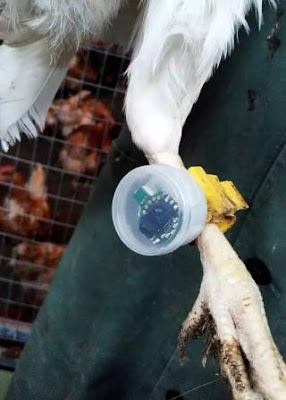Wearables are not a patent for humans. On many farms in the United States, animals wear various forms of wearable devices. The problem these devices are trying to solve is how to keep animals healthy in the context of large-scale farming. With new technology, farmers can detect problems in time, intervene in advance, and even affect the behavior of animals.
Animal researcher Micheal Toscano equips hens with RFID tags. He found that each hen has a specific behavior pattern. "Look at and compare their daily activity graphs, and you'll be amazed how, on any given day, a certain chicken is doing the same thing, all the time, like a little alarm clock inside," he told Wired.com.
Breeding should also be refined, and animals should be equipped with RFID tags and wearable devices
To study the data further, Toscano teamed up with John Brunnquell, a giant in the U.S. chicken industry. Brunnquell will conduct an experiment on three farms. What he wants to know is whether hens lay more eggs when they are not exposed to the scorching sun, or from predatory birds. He arranged some carriages with cameras. Cameras take pictures of the poultry as the wagon moves around the farm. "Today, we provide some shade and know where the chickens are going," Brunnquell said, "but we don't know how many chickens will pass, how long they will stay, and what will happen when they get there."
Next, Brunnquell will equip the chickens on the farm with RFID tags to track their movements. Because chicken behavior patterns are so fixed, farmers can easily build a monitoring system, Toscano said. Based on behavioral patterns and body temperature, the system can automatically identify sick or injured hens.
Breeding should also be refined, and animals should be equipped with RFID tags and wearable devices
Some farmers have gone a step further. When animals are in danger, technology can automatically step in. In pig farms, for example, about 10 percent of piglets die, and in half the cases, they are accidentally crushed to death while they go to their mother for warmth. During college, Matthew Rooda worked as a manager on a large pig farm in Iowa. He tried to solve this problem. "Thousands of piglets died on our farm," he said. "Pigs are smart. We can make them do all kinds of things. So I thought, 'Can we teach them not to crush their babies? ?'"
Rooda invented a wearable device. The device can be worn on the sow's stomach. It collects data when the pigs eat and drink, and at the same time, through the indoor temperature sensor, the pig farm can maintain a certain temperature, and the piglets do not have to go to the mother to warm up. A listening device is configured on a nearby monitor. If the piglet screams, the wearable device vibrates to remind the sow to leave. If the sow does not leave, she will deliver a light shock. According to Rooda's tests, 75% of the time, the shock is enough to make the sow stand up.
Next, Rooda's company, SwineTech, will demonstrate the technology at the World Pork Congress in Des Moines. However, it has already struck deals with some medium-sized pig farms in the United States. Rooda believes that his initial results mean the trend towards precision farming is coming.





No comments:
Post a Comment